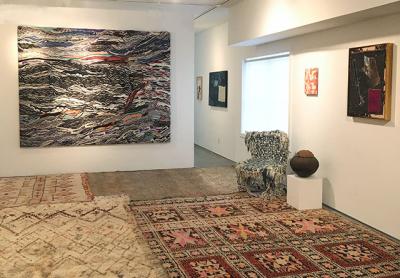Rental’s ‘Woven’ Excites and Soothes

It is not easy to warm up a typical white box gallery space, let alone make it cozy and fuzzy, but that is what the show “Woven” has done to the Rental Gallery in East Hampton.
Tonal and colorful rugs and woven pieces lie on the floor or hang on the walls, spanning the 19th century to the present, from the beauty and function of tribal craft to the high artistic impulse of contemporary practitioners of fiber art.
Mia Romanik, an art consultant based in Los Angeles and the curator of the show, said it came to her while she was setting up a place and covering concrete floors with a lot of rugs. “Everything was beginning to look entwined, interwoven,” she said in a statement.
Despite what might first be assumed to be limited options in terms of expression, the works on view demonstrate a broad variety. The artists are not shy about mixing or transforming mediums or making something look like something else. The diversity and invention is quite exciting, and somehow soothing.
The group of Moroccan rugs on the floor are the first hint that this exhibition will be more immersive installation than the typical art exhibition. From the Beni Mguld, Beni Ouarain, and Boujad tribes, they are alternately dense and fluffy, with traditional and more unusual patterns. Covering much of the floor, they provide a busy yet satisfying contrast to their companions on the walls.
Alvaro Barrington’s yarn-sewn found postcards near the entrance set the tone for the wall pieces. Small, striking, and evocative, the familiar European vistas and interiors are transformed with stitches as the artist creates negative space or otherwise disrupts them. Coming from a family of Grenadian and Haitian migrant workers, he has used sewing as a way of channeling female ancestors who were known for their needlework. Sensitive to the role of gender in this tradition, these works appear to subvert and undermine the European male-centric cultural tradition depicted in many of the cards.
He shares the space with Sheree Hovsepian and Josep Grau-Garriga. Grau-Garriga, a Spaniard who died in 2011, developed an early fascination with the tapestries he saw in the churches of Catalonia. “Personatge” demonstrates how he took that inspiration and added a three-dimensionality that transforms the jute, wool, and synthetic fiber into a hanging sculpture.
Ms. Hovsepian, who is from Iran and now based in New York, studied as a photographer, but wanted to have more of a hand in the process. She settled on photograms, using light-sensitve and undeveloped photo paper to create layered abstractions, such as “Text,” which includes nylon stocking material. The layers of paper and fabric in her work have “a lot of things to do with veiling, covering and uncovering what I’m making,” she told Vice last year.
Nearby is Alighiero Boetti’s 1988 embroidery “il silenzio e d’oro,” or silence is golden. It is a thought well-suited to these noisy times. Traditional needlepoint pillows have often employed sage and pithy sayings to contemplate as you recline on the couch. This is no different except the bold sans serif and blocky letters, arranged vertically as if reading a rebus, corrupt the dainty and plain-spoken style of the past.
A pairing of Zulu hair hats from South Africa and the woven glass beads of Liza Lou is particularly striking. Neither looks like it is made from the medium listed on the label. Ms. Lou’s beads are black and dull, offering only a slight shimmer that looks more like fabric. Reconciling the material qualities of the hats with their origin makes them both beautiful and jarring.
Dan Coopey takes found baskets and textiles and repairs or modifies them to his own ends. The Kuba textiles look like tapestries with his additions, notable but subtle. His baskets are more dramatic transformations, where he uses cylindrical shapes to disrupt their structure, leaving them to seem like beleaguered hosts to their growing forms.
There’s a lot here worth noting, and other standout pieces include the subtle tonal beauty of Jodie Carey’s pencil, dye, and plaster on woven canvas strips and Lucy Dodd’s “Gone Too Long,” a half chair/half beast, fashioned out of a co-opted Breuer frame embellished with thick cotton thread and blue pigment and reshaped with a branch and a stick. Antonio Pichilla’s loosely hanging cotton and polyester fibers on a wood support employ simple symbols to depict the four elements, in this case a pitcher for water, and a yellow abstraction that resembles a flame for fire.
Other artists in the show include Anne Cathrin November Hoibo, Sam Falls, Jayson Musson, Marina Pinsky, Sterling Ruby, Samantha Thomas, Ruby Sky Stiler, Kaari Upson, Hank Willis Thomas, Brian Wills, and Margo Wolowiec. It will remain on view through Jan. 31.
